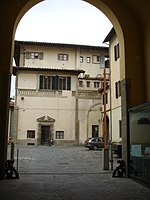San Giovannino dei Cavalieri

San Giovannino dei Cavalieri (Young St. John the Baptist of the Knights) previously named Church of San Giovanni Decollato (Decapitated St. John), is a parish church situated in Via San Gallo in central Florence, Italy. Initially the site held a 14th-century home for women of "easy virtue" and dedicated to St. Mary Magdalen, it was renamed after the patron saint of the Cavalieri or Knights of Malta. Rebuilt from 1553-1784, with facade added in 1699. Presently it contains a Coronation of the Virgin by Neri di Bicci, a Nativity by Bicci di Lorenzo, an Annunciation attributed to the Master of Stratonice, a Decapitation of St. John the Baptist by Pietro Dandini, vault frescoes by Alessandro Gherardini, a painted cross in the apse by Lorenzo Monaco, and a Last Supper by Palma il Giovane.
Excerpt from the Wikipedia article San Giovannino dei Cavalieri (License: CC BY-SA 3.0, Authors, Images).San Giovannino dei Cavalieri
Via San Gallo, Florence Quartiere 1
Geographical coordinates (GPS) Address Nearby Places Show on map
Geographical coordinates (GPS)
| Latitude | Longitude |
|---|---|
| N 43.779786111111 ° | E 11.258563888889 ° |
Address
Via San Gallo 56
50120 Florence, Quartiere 1
Tuscany, Italy
Open on Google Maps









